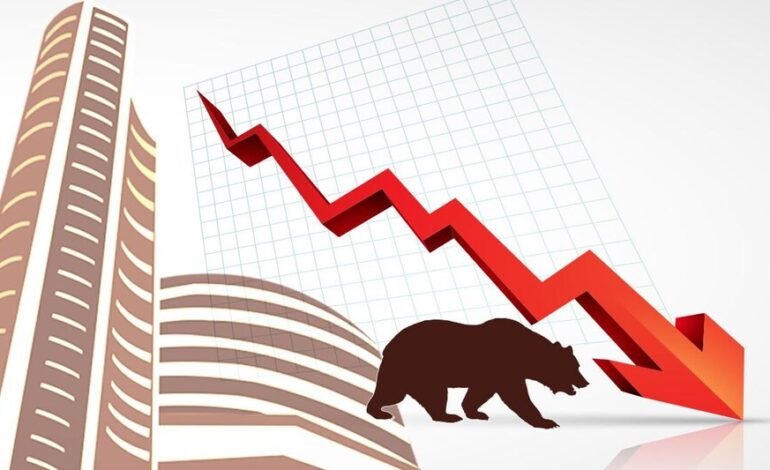In a day that rattled investors and shook Dalal Street to its core, Indian stock markets suffered their steepest single-day decline in nearly a year. The BSE Sensex plummeted 2,227 points (down 2.95%) to close at 73,137.90, while the Nifty 50 fell 742.85 points (down 3.24%) to settle at 22,161.60 on April 7, 2025. This marks the worst stock market crash in the last 10 months, driven by a combination of global tensions, weak economic cues, and aggressive sell-offs by institutional investors.
The dramatic fall sent shockwaves through all major sectors, leaving investors anxious and scrambling for safe assets. Here’s a comprehensive breakdown of what triggered this market rout and how you can navigate the volatility ahead.
Key Reasons Behind the Market Crash
1. Global Trade War Fears Escalate
The most significant trigger for this crash came from overseas. The recent announcement of tariff hikes by the United States on key global exports, including goods from Asia and Europe, ignited fears of a global trade war. These rising trade tensions are expected to:
- Increase global inflationary pressures
- Slow down economic growth
- Disrupt supply chains
Indian markets, closely tied to global economic health, reacted sharply to this development.
2. US Recession Worries
Worsening economic indicators in the United States, including weak job growth data and a rising unemployment rate, have intensified recession concerns. Wall Street’s overnight crash had a domino effect on Indian equities, triggering massive selling across the board.
3. FII Sell-Off
Foreign Institutional Investors (FIIs) pulled out massive funds from Indian equities amid global uncertainty. This bulk exit has added pressure on the already volatile markets, further intensifying the fall.
4. Rising Crude Oil Prices
Crude oil prices surged to over $95/barrel due to geopolitical tensions in the Middle East. This has raised fears of higher import bills and inflation in India, leading to market pessimism.
Sector-Wise Performance: Bloodbath Across the Board
The market crash wasn’t limited to a few sectors. All 13 major sectoral indices on the NSE ended in the red, with some recording significant losses.
Metal Sector
- Down 6.75%, the biggest loser of the day
- Stocks like JSW Steel and Tata Steel were hammered amid concerns about global demand
IT Sector
- Fell over 2.5% due to fears of lower outsourcing demand from a slowing US economy
- Infosys, TCS, and Wipro saw heavy losses
Banking & Financials
- Index dropped over 3%, dragged by top lenders like HDFC Bank, ICICI Bank, and SBI
- Concerns about loan growth and rising bond yields have weighed on the sector
Auto Sector
- Tata Motors plunged 5.6% after Jaguar Land Rover halted exports to the US
- Sector-wide pressure due to fears of demand slowdown and export restrictions
Top Nifty 50 Losers of the Day
| Company | Fall (%) |
|---|---|
| JSW Steel | -7.2% |
| Tata Motors | -5.6% |
| Hindalco | -5.1% |
| ICICI Bank | -3.9% |
| HDFC Bank | -3.5% |
| Infosys | -3.2% |
These heavyweight stocks dragged down the broader indices significantly due to their high weightage in Nifty and Sensex.
Surge in Market Volatility
The India VIX (Volatility Index) soared by 66%, marking the largest single-day spike in a decade. This sharp rise in VIX reflects heightened fear and uncertainty among investors and traders.
A high VIX usually signals turbulent times ahead and suggests that market participants are anticipating wide price swings in the coming sessions.
What Should Investors Do Now?
Don’t Panic Sell
Markets are inherently volatile. Selling in panic can lock in losses. Long-term investors should stay focused on their financial goals.
Rebalance Portfolio
This could be a good opportunity to rebalance portfolios. Add fundamentally strong stocks at attractive valuations and reduce exposure to overvalued or highly volatile sectors.
Focus on Defensive Sectors
Consider increasing exposure to FMCG, Pharma, and Utilities, which are more resilient in times of economic stress.
Keep an Eye on US Data & Global News
Continue tracking global cues, particularly from the US Federal Reserve and any geopolitical developments that could influence investor sentiment.
Expert Outlook
Market analysts suggest that this correction, while sharp, may offer long-term buying opportunities, especially for value investors.
“The fundamentals of the Indian economy remain strong. However, external global shocks are driving short-term volatility. Investors with a 3-5 year horizon should stay put and use this dip to accumulate quality stocks,” said Anuj Mehta, Senior Market Analyst at Axis Securities.
What to Expect This Week
With earnings season around the corner and multiple macroeconomic indicators expected to be released, the upcoming week will be critical for market direction.
Keep an eye on:
- US CPI data
- India’s industrial production numbers
- Quarterly results of top Indian firms
These factors will dictate whether this is a temporary correction or the beginning of a deeper market pullback.
Final Thoughts
The April 7 market crash is a reminder of how global uncertainties and economic fears can significantly impact domestic equities. While the fall was steep, it’s important to maintain a calm, strategic approach.
Whether you’re a retail investor or a seasoned trader, staying informed, reviewing your portfolio, and sticking to a long-term plan is essential in navigating such turbulent times.







